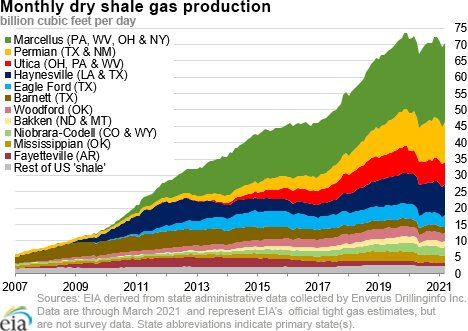In the News:
Growth in U.S. ethane consumption outpaces all other major fuels
U.S. consumption of ethane, which EIA reports as product supplied, grew by 165,000 barrels per day (b/d), or 10.7%, in 2020. Ethane consumption grew as a share of U.S. petroleum liquids consumption from 7.5% in 2019 to 9.4% in 2020. Consumption of all other major fuels, by sharp contrast, declined. In 2020, natural gas delivered to consumers fell by 2.1%, propane consumption declined by 6.5%, distillate product supplied fell by 8.0%, gasoline product supplied declined by 13.7%, and jet fuel consumption fell by 38.2%.
U.S. demand for ethane has been growing steadily as a result of capacity expansions of ethylene crackers in the petrochemical industry, which uses ethane as a feedstock. U.S. ethane product supplied nearly doubled from 874,000 b/d in 2010 to 1.7 million b/d in 2020, a faster rate of growth than for any other energy product. Exports of ethane, which began in 2014, reached 281,000 b/d in 2020. In response, U.S. ethane production increased. Ethane recovery at gas processing plants, which produce almost 100% of all ethane produced in the United States, rose by 131% from 869,000 b/d in 2010 to 2.0 million b/d in 2020 as a result of both higher volumes of natural gas processed and of higher share of ethane recovered from this processed natural gas.
In our Short-Term Energy Outlook (STEO), we forecast 130,000 b/d of additional ethane production in 2021 compared with 2020. This forecast increase accounts for significant demand destruction as a result of the February 2021 winter storm that affected most petrochemical plants along the Gulf Coast. In 2022, we forecast an additional 320,000 b/d of ethane production as a result of three new petrochemical plants that will come online between mid-2021 and mid-2022 (two in Texas and one in Pennsylvania) and as exports of ethane continue to grow in response to expanding petrochemical cracking capacity in China, Canada, and Mexico.
Unlike most other energy products, ethane, which is produced along with raw natural gas, is either recovered as a liquid from the raw natural gas stream at a natural gas processing plant and sold into the petroleum market or left unrecovered in the dry-gas stream (a process referred to as ethane rejection) and sold into the natural gas market for its heat value. The decision as to whether to recover or reject ethane is based on a number of factors, including:
- The quality of dry gas that interstate natural gas pipeline operators require
- The specifications of mixed natural gas plant liquids (NGPLs) that pipelines require in order to ship it from the natural gas processing plant to downstream fractionation plants that separate ethane and other NGPLs into purity products
- The value of ethane as a liquid (priced in cents per gallon) relative to its value as part of the dry gas stream (priced in dollars per MMBtu ($/MMBtu))
Because ethane may be either removed from or rejected into dry natural gas, its recovery from raw natural gas in greater quantities results in lower volumes of dry gas produced. Each barrel of ethane, if sold for its heat value as part of the dry natural gas stream, contributes 1,588 cubic feet of volume in its gaseous state. As a result, the additional 182,000 b/d of ethane produced in 2020 compared with 2019 reduced dry gas volumes by approximately 290 million cubic feet per day (MMcf/d)—or approximately 17% of the total decline in dry natural gas production in 2020, which fell by 1,700 MMcf/d. We expect demand for ethane, and therefore ethane recovery, to continue growing, which will affect both the heat content and total marketed volume of dry natural gas.
Overview:
(For the week ending Wednesday, April 28, 2021)
- Natural gas spot prices rose in most regions this report week (Wednesday, April 21 to Wednesday, April 28). The Henry Hub spot price rose from $2.65 per million British thermal units (MMBtu) last Wednesday to $2.93/MMBtu yesterday.
- At NYMEX, the May 2021 contract expired yesterday at $2.925/MMBtu, up 23¢/MMBtu from last Wednesday. The June 2021 contract price increased to $2.960/MMBtu, up 18¢/MMBtu from last Wednesday to yesterday. The price of the 12-month strip averaging June 2021 through May 2022 futures contracts climbed 11¢/MMBtu to $2.990/MMBtu.
- The net injections to working gas totaled 15 billion cubic feet (Bcf) for the week ending April 23. Working natural gas stocks totaled 1,898 Bcf, which is 14% lower than the year-ago level and 2% lower than the five-year (2016–2020) average for this week.
- The natural gas plant liquids composite price at Mont Belvieu, Texas, rose by 21¢/MMBtu, averaging $7.07/MMBtu for the week ending April 28. The average weekly price of natural gasoline fell by 1%, reflecting the price decline in the Brent crude oil price, which also fell 1% week over week. The price of ethane increased 5%, in response to rising demand for petrochemical feedstock use and anticipated increased exports because of the scheduled arrival of multiple large ethane gas carriers at Gulf Coast export terminals this week and next, each capable of carrying almost 900,000 barrels. Prices of propane, butane, and isobutane rose by 3%, 5%, and 5%, respectively, also in response to elevated exports. Propane exports remain strong and averaged nearly 1.2 million b/d for the four weeks ending April 23, although inventories are at their lowest level since April 2018.
- According to Baker Hughes, for the week ending Tuesday, April 20, the natural gas rig count remained steady at 94, the highest number since April 9, 2020. The number of oil-directed rigs fell by 1 to 343. The total rig count decreased by 1, and it now stands at 438.
Prices/Supply/Demand:
Natural gas prices rise in most markets as demand remains robust in response to elevated power generation demand. Temperatures along the Gulf Coast rose late in the report week, with nighttime temperatures in the 70s—up to 12ºF above normal, on Tuesday and yesterday. IHS Markit estimates power generation rose in the Southeast above 10 Bcf/d for the first time since October 28 of last year and in Texas to the highest levels since February 20. The Henry Hub spot price rose 28¢ from $2.65/MMBtu last Wednesday to $2.93/MMBtu yesterday.
Midwest prices rise, as the polar vortex disruption, which developed in late January, continues to affect weather in the region. Temperatures in the region oscillated widely, resulting in relatively rapid shifts from heating demand to cooling demand. These shifts elevated residential and commercial demand for natural gas early in the week and demand for power generation toward the end of the report week as air-conditioning load developed in major consumption centers. Maximum temperatures in Chicago reached 59ºF last Thursday, or 3ºF below normal; dropped as low as 47ºF, or 16ºF below normal on Sunday; and then rose to 78ºF, or 15ºF above normal, on Monday and 86ºF, or 22ºF above normal, on Tuesday. The significantly warmer weather coincided with elevated demand for natural gas for power generation in the Midwest. According to IHS Markit, demand for natural gas for power generation increased from less than 2.4 Bcf/d on Sunday to 3.6Bcf/d on Tuesday and more than 4.1 Bcf/d yesterday as a result. Prices at the Chicago Citygate and across the Midwest rose in response, reaching weekly highs yesterday. At the Chicago Citygate, the price increased 10¢ from $2.68/MMBtu last Wednesday to $2.78/MMBtu yesterday. The Natural Gas Intelligence Midwest Regional average rose by 15¢, from $2.62/MMBtu last Wednesday to $2.77/MMBtu yesterday. Both prices recorded weekly lows on Friday, at $2.60/MMBtu and $2.57/MMBtu, respectively.
Prices in Northern California rise, while prices in Southern California decline week over week. The price at PG&E Citygate in Northern California rose 10¢, up from $3.92/MMBtu last Wednesday to $4.02/MMBtu yesterday, after reaching a weekly high of $4.19/MMBtu on Tuesday. Northern California prices reflected price movements at two major supply points into the region. The price at Sumas on the Canada-Washington border rose 14¢ from $2.67/MMBtu last Wednesday to $2.81/MMBtu yesterday. The price at Opal Hub in southwest Wyoming, the origin point for deliveries into the California market via the Ruby Pipeline, rose 14¢ from $2.74/MMBtu last Wednesday to $2.88/MMBtu yesterday. Both pricing points also reached weekly highs on Tuesday, at $2.92/MMBtu and $2.97/MMBtu, respectively.
The price at SoCal Citygate in Southern California decreased 11¢ from $3.59/MMBtu last Wednesday to $3.48/MMBtu yesterday, after reaching a weekly high of $3.80 on Monday. SoCalGas reports continuing maintenance outage at the Honor Rancho storage field, limiting injections during a period of seasonal stock-building. This outage has reduced the system’s ability to balance, necessitating a Critical Notice declaration and pushing prices lower.
Prices in the Northeast decline in response to moderate temperatures and reduced space heating demand. At the Algonquin Citygate, which serves Boston-area consumers, the price went down $1.67 from $4.14/MMBtu last Wednesday to $2.47/MMBtu yesterday, after falling to a weekly low of $2.16 on Friday. Enbridge reports continuing maintenance outage at the Weymouth compressor station 12 miles northwest of Boston on the Algonquin Gas Transmission, LLC pipeline, limiting deliveries into the New England market out of the Appalachian Basin production area. Although reduced supply leads to upward price pressure, the reduced deliverability into the market has been offset somewhat by mild temperatures. In Boston, temperatures reached a daily high of 74ºF on Saturday—15ºF above normal. The warmer-than-normal trend continued through Tuesday and yesterday, as most of the region saw averages in the 60s, reducing space heating demand. At the Transcontinental Pipeline Zone 6 trading point for New York City, the price decreased 21¢ from $2.57/MMBtu last Wednesday to $2.36/MMBtu yesterday, after reaching a weekly low of $2.17/MMBtu on Friday.
Prices in the Appalachian Basin production region are mixed. After falling to multi-month lows last week because of pipeline congestion in the New England consuming region, the Tennessee Zone 4 Marcellus spot price increased 39¢ from $1.52/MMBtu last Wednesday to $1.91/MMBtu yesterday. The Tennessee Zone 4 price rose as high as $2.06/MMBtu on Tuesday, the highest level since March 12. The price at Dominion South in southwest Pennsylvania fell 8¢ from $2.32/MMBtu last Wednesday to $2.24/MMBtu yesterday, after falling to $2.09/MMBtu last Thursday, reflecting declining demand in the Northeast market.
Permian prices rise, following the Henry Hub price higher. The price at the Waha Hub in West Texas, which is located near Permian Basin production activities, rose 26¢ week over week, from $2.50/MMBtu last Wednesday to $2.76/MMBtu yesterday. The Waha discount relative to Henry Hub widened from 15¢/MMBtu last Wednesday to 17¢/MMBtu yesterday, reflecting suppressed demand in the Southern California market (see discussion above).
Total supply of natural gas remains mostly flat. According to data from IHS Markit, the average total supply of natural gas rose slightly by 0.3% compared with the previous report week. Dry natural gas production grew by 0.9% compared with the previous report week. Average net imports from Canada decreased by 9.5% after a large increase last week. Net imports from Canada averaged 4.7 Bcf/d this week compared with 5.1 Bcf/d last week and 3.8 Bcf/d for this week last year.
Residential and commercial sector demand falls because of mild temperatures. Total U.S. consumption of natural gas fell by 5.9% compared with the previous report week, according to data from IHS Markit. Natural gas consumed for power generation climbed by 1.5% week over week. Industrial sector consumption decreased by 3.0% week over week. In the residential and commercial sectors, consumption declined by 17.7% to 18 Bcf/d from 21.9 Bcf/d last week in response to seasonally rising temperatures across the Lower 48 states. Natural gas exports to Mexico decreased 4.7% to a level that is 28.1% higher than the same week last year. Natural gas deliveries to U.S. liquefied natural gas (LNG) export facilities (LNG pipeline receipts) averaged above 11.0 Bcf/d for the seventh week in a row at 11.3 Bcf/d, or 0.29 Bcf/d lower than last week.
U.S. LNG exports are flat week over week. Twenty LNG vessels (seven from Sabine Pass, four each from Cameron and Freeport, three from Corpus Christi, and two from Cove Point) with a combined LNG-carrying capacity of 73 Bcf departed the United States between April 22 and April 28, 2021, according to shipping data provided by Bloomberg Finance, L.P.
Storage:
The net injections into storage totaled 15 Bcf for the week ending April 23, compared with the five-year (2016–2020) average net injections of 67 Bcf and last year's net injections of 66 Bcf during the same week. Working natural gas stocks totaled 1,898 Bcf, which is 40 Bcf lower than the five-year average and 302 Bcf lower than last year at this time.
According to The Desk survey of natural gas analysts, estimates of the weekly net change to working natural gas stocks ranged from net withdrawals of 2 Bcf to net injections of 28 Bcf, with a median estimate of net injections of 10 Bcf.
More storage data and analysis can be found on the Natural Gas Storage Dashboard and the Weekly Natural Gas Storage Report.
See also:
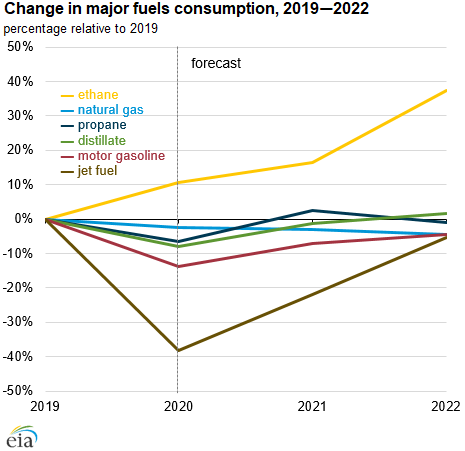 Source: U.S. Energy Information Administration Petroleum Supply Monthly and Short Term Energy Outlook April 2021
Source: U.S. Energy Information Administration Petroleum Supply Monthly and Short Term Energy Outlook April 2021
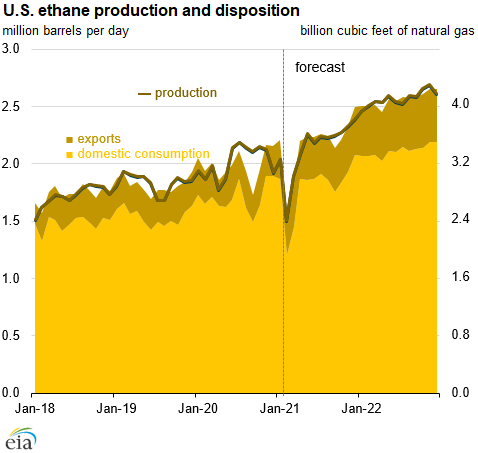 Source: U.S. Energy Information Administration Petroleum Supply Monthly and Short Term Energy Outlook April 2021
Source: U.S. Energy Information Administration Petroleum Supply Monthly and Short Term Energy Outlook April 2021
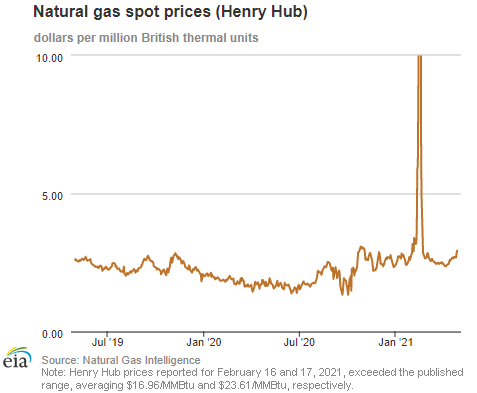
| Spot Prices ($/MMBtu) | Thu, 22-Apr |
Fri, 23-Apr |
Mon, 26-Apr |
Tue, 27-Apr |
Wed, 28-Apr |
|---|---|---|---|---|---|
| Henry Hub |
2.67 |
2.71 |
2.69 |
2.85 |
2.93 |
| New York |
2.20 |
2.17 |
2.39 |
2.40 |
2.36 |
| Chicago |
2.64 |
2.60 |
2.60 |
2.78 |
2.78 |
| Cal. Comp. Avg.* |
3.15 |
3.21 |
3.37 |
3.46 |
3.34 |
| Futures ($/MMBtu) | |||||
| May contract | 2.749 |
2.730 |
2.790 |
2.873 |
2.925 |
| June contract |
2.831 |
2.818 |
2.874 |
2.942 |
2.960 |
| *Avg. of NGI's reported prices for: Malin, PG&E Citygate, and Southern California Border Avg. | |||||
| Source: NGI's Daily Gas Price Index | |||||
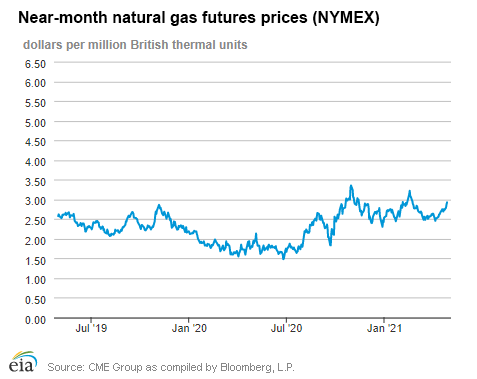
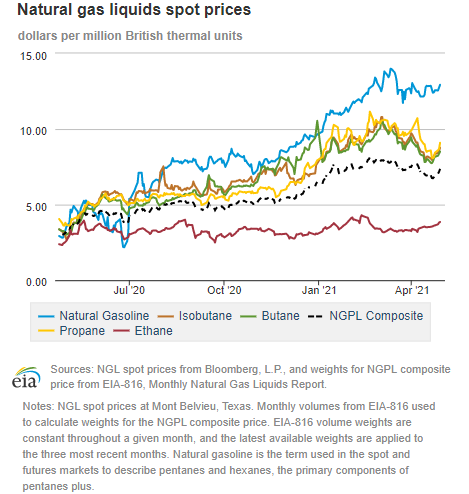
| U.S. natural gas supply - Gas Week: (4/22/21 - 4/28/21) | |||
|---|---|---|---|
Average daily values (Bcf/d): |
|||
this week |
last week |
last year |
|
| Marketed production | 102.9 |
102.0 |
102.4 |
| Dry production | 91.4 |
90.6 |
91.2 |
| Net Canada imports | 4.7 |
5.1 |
3.8 |
| LNG pipeline deliveries | 0.1 |
0.1 |
0.1 |
| Total supply | 96.1 |
95.8 |
95.1 |
|
Source: IHS Markit | |||
| U.S. natural gas consumption - Gas Week: (4/22/21 - 4/28/21) | |||
|---|---|---|---|
Average daily values (Bcf/d): |
|||
this week |
last week |
last year |
|
| U.S. consumption | 66.8 |
71.0 |
65.0 |
| Power | 26.1 |
25.7 |
24.8 |
| Industrial | 22.7 |
23.4 |
21.0 |
| Residential/commercial | 18.0 |
21.9 |
19.1 |
| Mexico exports | 6.0 |
6.3 |
4.7 |
| Pipeline fuel use/losses | 6.2 |
6.4 |
6.3 |
| LNG pipeline receipts | 11.3 |
11.6 |
7.6 |
| Total demand | 90.4 |
95.3 |
83.6 |
|
Source: IHS Markit | |||
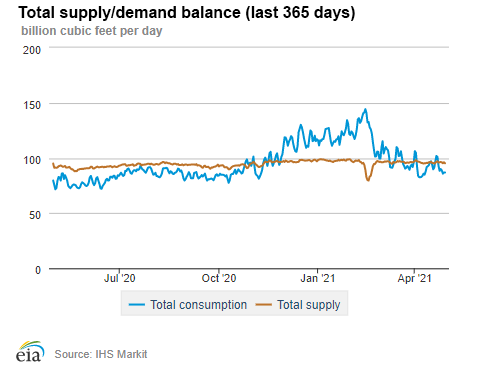
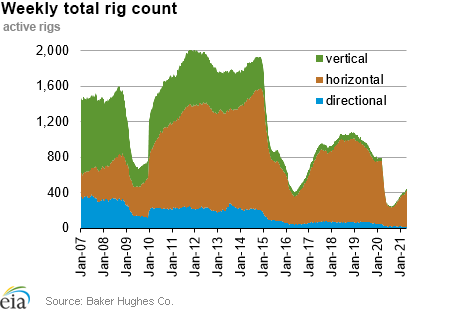
| Rigs | |||
|---|---|---|---|
Tue, April 20, 2021 |
Change from |
||
last week |
last year |
||
| Oil rigs | 343 |
-0.3% |
-9.3% |
| Natural gas rigs | 94 |
0.0% |
10.6% |
| Note: Excludes any miscellaneous rigs | |||
| Rig numbers by type | |||
|---|---|---|---|
Tue, April 20, 2021 |
Change from |
||
last week |
last year |
||
| Vertical | 22 |
4.8% |
37.5% |
| Horizontal | 397 |
-0.3% |
-6.8% |
| Directional | 19 |
-5.0% |
-17.4% |
| Source: Baker Hughes Co. | |||
| Working gas in underground storage | ||||
|---|---|---|---|---|
Stocks billion cubic feet (Bcf) |
||||
| Region | 2021-04-23 |
2021-04-16 |
change |
|
| East | 319 |
325 |
-6 |
|
| Midwest | 427 |
421 |
6 |
|
| Mountain | 119 |
118 |
1 |
|
| Pacific | 217 |
210 |
7 |
|
| South Central | 816 |
810 |
6 |
|
| Total | 1,898 |
1,883 |
15 |
|
|
Source: Form EIA-912, Weekly Underground Natural Gas Storage Report | ||||
| Working gas in underground storage | |||||
|---|---|---|---|---|---|
Historical comparisons |
|||||
Year ago (4/23/20) |
5-year average (2016-2020) |
||||
| Region | Stocks (Bcf) |
% change |
Stocks (Bcf) |
% change |
|
| East | 404 |
-21.0 |
326 |
-2.1 |
|
| Midwest | 504 |
-15.3 |
412 |
3.6 |
|
| Mountain | 102 |
16.7 |
113 |
5.3 |
|
| Pacific | 217 |
0.0 |
210 |
3.3 |
|
| South Central | 974 |
-16.2 |
877 |
-7.0 |
|
| Total | 2,200 |
-13.7 |
1,938 |
-2.1 |
|
| Source: Form EIA-912, Weekly Underground Natural Gas Storage Report | |||||
| Temperature – heating & cooling degree days (week ending Apr 22) | ||||||||
|---|---|---|---|---|---|---|---|---|
HDD deviation from: |
CDD deviation from: |
|||||||
| Region | HDD Current |
normal |
last year |
CDD Current |
normal |
last year |
||
| New England | 132 |
8 |
-30 |
0 |
0 |
0 |
||
| Middle Atlantic | 119 |
12 |
-34 |
0 |
0 |
0 |
||
| E N Central | 148 |
38 |
-22 |
0 |
0 |
0 |
||
| W N Central | 157 |
57 |
3 |
0 |
-1 |
0 |
||
| South Atlantic | 70 |
20 |
-12 |
20 |
3 |
-7 |
||
| E S Central | 85 |
40 |
6 |
0 |
-5 |
0 |
||
| W S Central | 63 |
44 |
24 |
4 |
-19 |
-15 |
||
| Mountain | 140 |
35 |
13 |
5 |
-4 |
3 |
||
| Pacific | 48 |
-14 |
-17 |
0 |
-3 |
0 |
||
| United States | 107 |
24 |
-12 |
4 |
-4 |
-3 |
||
|
Note: HDD = heating degree day; CDD = cooling degree day Source: National Oceanic and Atmospheric Administration | ||||||||
Average temperature (°F)
7-day mean ending Apr 22, 2021
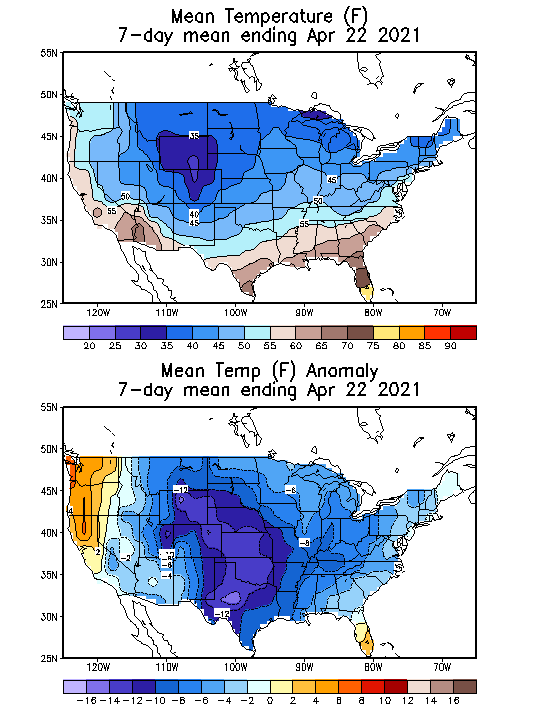
Source: National Oceanic and Atmospheric Administration
Deviation between average and normal (°F)
7-day mean ending Apr 22, 2021

Source: National Oceanic and Atmospheric Administration

